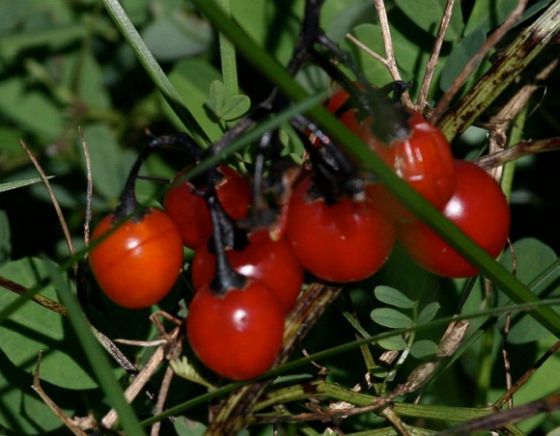No, these aren’t tomatoes. They’re related to tomatoes, but don’t eat them. They’re poisonous.
These are the fruits of Bittersweet Nightshade (Solanum dulcamara), a common weed in North America that’s native to Europe and Asia. Click on the photo to see its flowers.
Until I did the research for this blog, I called this plant Deadly Nightshade but that’s the common name for a completely different and far more deadly plant, Atropa Belladonna. Belladonna is so poisonous that 2-5 of its deep blue berries can kill a child, 10-20 berries or a single leaf can kill an adult. In Ancient Rome the aristrocracy found it quite effective for killing their rivals.
Both plants are in the Nightshade family (Solanaceae) which includes a wide variety of edible and poisonous species. The edible plants are so tasty that humans went to the trouble of cultivating them: potatoes, tomatoes, eggplants, chili peppers and paprika. The toxic plants are beautiful but dangerous: Deadly Nightshade, Bittersweet Nightshade, Mandrake and Jimson Weed (Datura), to name a few.
Somewhere in humanity’s past, people had to figure out which plants were good to eat and which weren’t. What a risky business! I’m glad that job is done and we’re able to pass on the knowledge.
Meanwhile, don’t worry that you’ll mistake these berries for tomatoes. Bittersweet Nightshade berries are tiny and the plant smells bad.
(photos by Chuck Tague)

Kate–Not directly on point, but did you know the “early blight” which has destroyed so many of our wonderful tomatoes is caused by the same fungus that caused the Irish Potato Famine 1850-53? Since potatoes and tomatoes are in the same family (as you wrote) each is vulnerable to diseases affecting the other. Although it is thought the fungus was brought to this area by “big-box nursery” plants from the South, it is airborne, so has destroyed entire fields of tomatoes. Plants must be totally eradicated–pulled up and bagged, not composted–so the fungus can’t winter over.
In Ireland, the farmers harvested healthy-looking potatoes, only to find them blackened and watery/shriveled the next day. Same w/ our tomatoes, according to the farmers I’ve talked with. Irish farmers were essentially share-croppers, exporting wheat, produce and meat, mainly to their British landlords, and surviving on their potato crop only. When that failed, they were turned out of their farms and starved. The lucky ones emigrated. A boon for USA, Canada, and Australia, but not so good for Ireland!
Anne
Thanks I had always called it deadly Nightshade too. Now I know better.
What to do if you find this plant
This plant is a common native in the eastern U.S. so I don’t bother with it unless it comes up as a weed in my garden. I’m not sure if it’s invasive in other parts of the world. If so, it may require an effort to get rid of it.
found this plant along a wooded footpath … @ a local historic old church… while walking dogs , my friend alerted me …. to it knew belladonna was a deep purple colour …. just saying thanks for the up date
Thanks Kate. As with lots of deadly things the enticement is looks, the flower is very pretty.
Some have white flowers